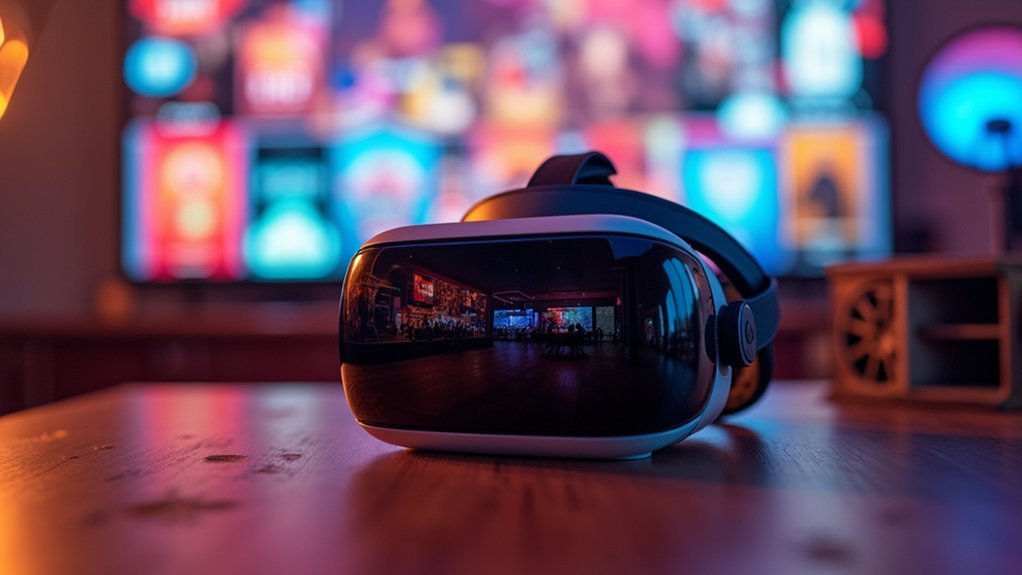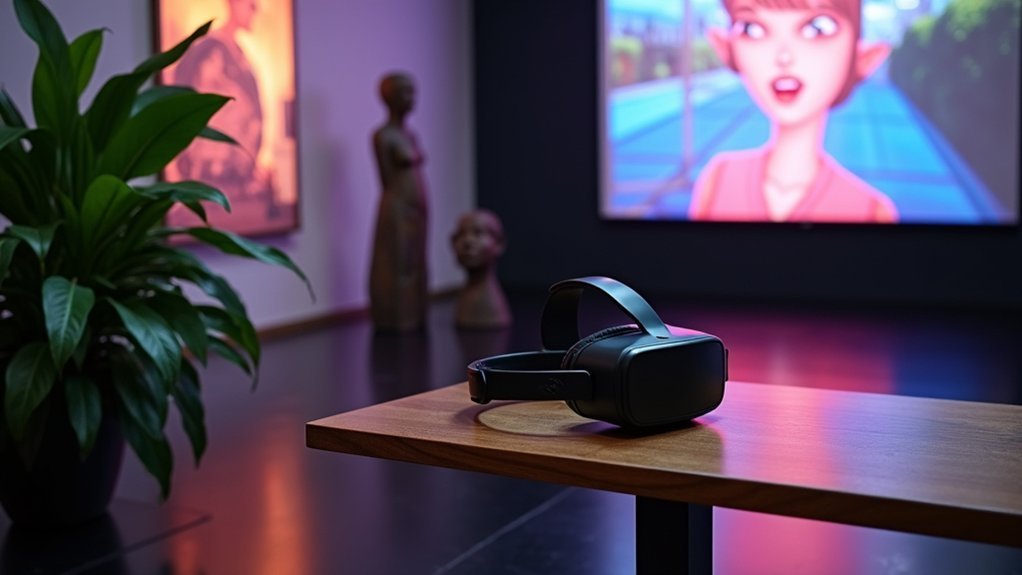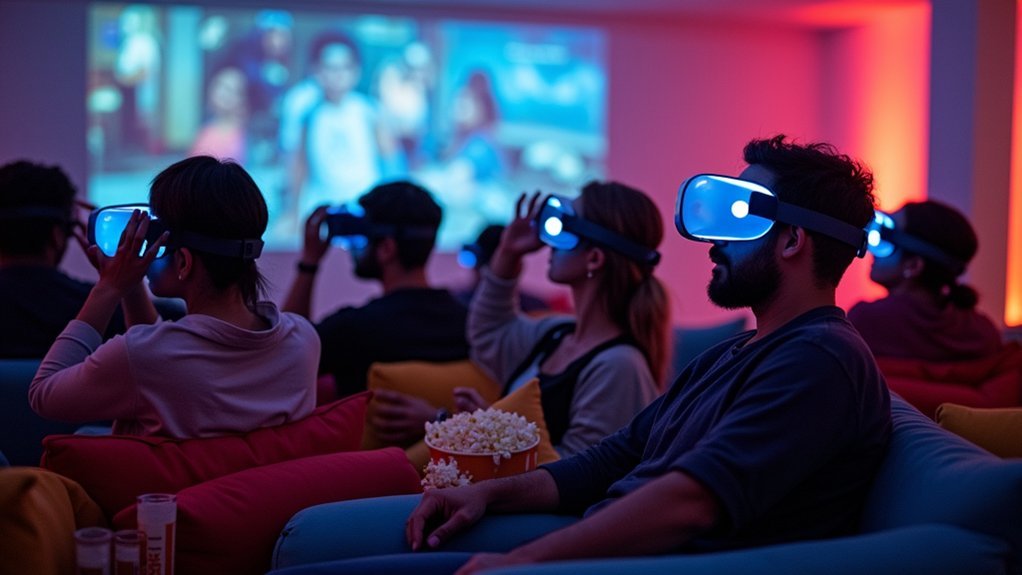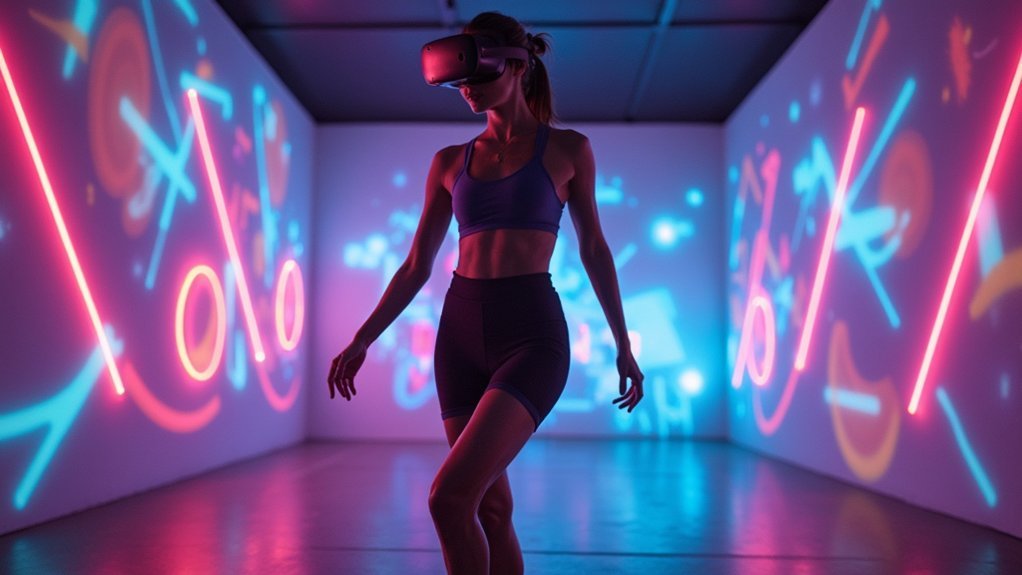You can transform your VR headset into a premium festival experience by curating content from platforms like Oculus TV, Steam VR, and Museum of Other Realities. Focus on award-winning narratives from Sundance and Cannes, including interactive documentaries like “Carne y Arena” and “Hunger in L.A.” Prioritize high-resolution headsets with spatial audio for immersive storytelling. Follow festival programming from Tribeca and SXSW for cutting-edge releases, and engage with VR communities for insider recommendations on emerging cinematic experiences that’ll elevate your home viewing setup.
Building Your Personal VR Festival Library

When building your personal VR festival library, you’ll want to start by exploring established platforms like Oculus TV and Steam, which offer diverse collections of immersive narratives and 360-degree cinematic experiences.
Established platforms like Oculus TV and Steam provide the foundation for curating diverse immersive narratives and cinematic VR experiences.
These platforms showcase curated VR experiences from major film festivals worldwide.
To enhance your collection, utilize the Museum of Other Realities for interactive 3D art installations.
Stay current by following festival programming from Tribeca and SXSW, which highlight cutting-edge VR projects and emerging technologies.
Build your library strategically by checking FilmFreeway, where film festivals list their VR programming with community reviews.
This helps you identify quality content efficiently.
Experiment with different headsets like Samsung Gear VR or Oculus Rift to optimize your viewing experience across various immersive storytelling formats.
Essential Hardware for Festival Experience Curation
You’ll need to carefully evaluate VR headsets based on display resolution, field of view, and tracking capabilities to guarantee ideal viewing of festival content.
Your audio setup deserves equal attention since immersive films rely heavily on spatial sound design to create believable environments.
Consider investing in high-quality headphones or surround sound systems that can accurately reproduce the nuanced audio layers that make festival experiences truly enthralling.
Headset Selection Criteria
How do you choose the right VR headset when countless options flood the market? Your headset selection criteria should prioritize compatibility with festival platforms like Oculus and HTC Vive, as many festivals use specific VR hardware requirements.
Budget plays a significant role—Samsung Gear VR and Google Cardboard offer affordable entry points, while Oculus Rift and HTC Vive deliver premium graphics at higher costs.
Comfort becomes essential during extended viewing sessions, especially for longer narrative experiences. You’ll need sufficient resolution and refresh rates for smooth, visually appealing storytelling.
Don’t overlook additional accessories like sound collars or external controllers that enhance interactivity during festival showcases. These factors collectively determine whether your VR hardware will deliver an ideal festival experience.
Premium Audio Requirements
Beyond visual clarity, exceptional audio transforms VR film experiences from impressive demonstrations into truly transportive journeys. Your premium audio requirements extend well beyond standard headset speakers to create truly immersive experiences.
Consider investing in spatial audio headphones or sound collars that deliver nuanced directional sound. While headsets like Oculus Quest and HTC Vive include built-in spatial audio, dedicated premium equipment elevates your festival curation considerably.
You’ll want separate audio interfaces and DACs to guarantee crystal-clear sound that matches your visual fidelity. These components eliminate audio compression artifacts that can break immersion during critical narrative moments.
Don’t overlook proper audio calibration within your VR environment. Correctly configured sound directionality and depth perception make virtual worlds feel authentically three-dimensional, transforming your curated festival into an unforgettable cinematic journey.
Discovering Award-Winning Immersive Narratives

When you step into the world of award-winning immersive narratives at film festivals, you’re entering a domain where traditional storytelling boundaries dissolve into groundbreaking artistic experiences.
These VR experiences have earned prestigious recognition alongside conventional films, proving their artistic legitimacy at festivals like Sundance and Cannes.
You’ll discover transformative projects that redefine narrative engagement:
- Nonny de la Peña’s “Hunger in L.A.” – premiered at Sundance 2012, pioneering documentary VR storytelling
- Alejandro González Iñárritu’s “Carne y Arena” – showcased at Cannes 2017, blending physical and virtual environments
- “Reeducated” – addressing marginalized communities’ experiences through immersive perspectives
The growth from one to 1,800 VR programs demonstrates festivals’ commitment to these innovative narratives.
You’re witnessing storytelling evolution that encourages interactivity, sparks social dialogue, and transforms passive viewing into active participation.
Platform-Specific Content Collections and Access
As immersive narratives gain recognition at prestigious festivals, accessing these award-winning experiences depends largely on traversing platform-specific content collections that each offer distinct advantages and limitations. Each VR experience requires careful consideration of where you’ll find the most compelling content for your headset.
| Platform | Content Focus | Strengths | Weaknesses | Best For |
|---|---|---|---|---|
| Oculus TV | Immersive stories | User-friendly interface, premium content | Limited artistic diversity | Narrative experiences |
| Steam | Gaming + cinema | Vast library, 360 videos | Gaming overshadows art | Mixed content consumption |
| Viveport | Gaming-focused | Established ecosystem | Limited narrative exposure | Gaming enthusiasts |
| Museum of Other Realities | Interactive art | Cutting-edge experiences | Smaller content library | Art connoisseurs |
| General Distribution | Mixed platforms | Broad accessibility | Fragmented experience | Platform comparison |
Understanding these distribution platforms helps you navigate toward festival-quality content efficiently.
Navigating Virtual Exhibition Spaces and Galleries

When you’re designing virtual gallery layouts for your film festival, you’ll need to contemplate how visitors will move through immersive 3D spaces that feel both intuitive and engaging.
Your interactive navigation controls should allow attendees to seamlessly explore exhibitions using simple gestures or commands while maintaining the social atmosphere that platforms like Museum of Other Realities provide through spatialized voice chat.
You’ll want to showcase films and installations using immersive display methods that transform traditional screening experiences into interactive environments where festival-goers can discuss content with their avatars in real-time.
Virtual Gallery Layout Design
While traditional gallery spaces rely on physical architecture to guide visitor flow, virtual gallery layout design demands a completely reimagined approach to spatial storytelling.
You’ll need to craft virtual environments that feel intuitive while leveraging the unique possibilities of digital space. Your layout should create natural pathways that draw viewers from piece to piece, using visual cues and strategic placement to maintain engagement.
Consider these essential design elements:
- Spatial hierarchies that highlight featured films while maintaining discoverable secondary content
- Interactive experiences like 360-degree viewing pods and immersive screening rooms
- Flexible zones that accommodate both individual exploration and group viewing sessions
You’ll want to balance open spaces for comfortable navigation with intimate alcoves for focused film appreciation, ensuring your virtual festival feels both expansive and personal.
Interactive Navigation Controls
The most thoughtfully designed virtual gallery layout becomes meaningless without intuitive controls that let you navigate the space effortlessly.
Interactive navigation controls transform your film festival exploration by enabling seamless movement through immersive environments where every artwork and screening space becomes accessible.
Advanced VR systems utilize hand-tracking technology, letting you interact naturally without clunky controllers.
You’ll point, gesture, and grab virtual objects as if they’re physically present. Spatial audio provides directional sound cues that help you orient yourself within the virtual space, creating a more intuitive experience.
Teleportation mechanics allow quick movement between exhibition areas by simply selecting points within your field of view.
Visual indicators and prompts guide you through the festival while maintaining engagement, ensuring you won’t miss vital screenings or installations.
Immersive Art Display Methods
Beyond traditional wall-mounted displays, virtual film festivals revolutionize how you experience art through three-dimensional installations that surround and envelop you completely.
VR exhibitions transform how you engage with cinematic works, allowing you to step inside narrative spaces and interact with storytelling elements in ways impossible through conventional screens.
Platforms like the Museum of Other Realities enable these immersive experiences by providing:
- Shared virtual environments where you can explore 3D art installations alongside other festival attendees
- Spatialized voice chat through systems like Normal VR’s Normcore for real-time conversations about the works
- Dynamic room roaming capabilities that let you navigate seamlessly between different exhibition spaces
You’ll create custom avatars and engage in meaningful discussions while accessing large-scale artistic works that might otherwise remain geographically inaccessible.
Documentary and Journalism Focus Collections
Since Nonny de la Peña’s groundbreaking “Hunger in L.A.” premiered at Sundance in 2012, VR documentaries have transformed how audiences experience real-world stories, moving beyond traditional observation to create powerful immersive encounters.
You’ll find exceptional works like Felix & Paul Studios’ “Strangers with Patrick Watson,” which crafts intimate personal narratives that forge deep emotional connections.
Alejandro González Iñárritu’s “Carne y Arena” exemplifies documentary VR’s potential by placing you directly into refugees’ asylum-seeking experiences.
Major festivals now showcase these immersive journalistic pieces, with Venice Biennale and Cannes featuring VR works addressing critical social issues.
Prestigious film festivals have embraced VR documentaries, with Venice Biennale and Cannes prominently featuring immersive works that tackle pressing social issues.
While distribution remains challenging, platforms like Oculus TV are expanding access to this innovative storytelling medium, making thought-provoking documentary content more accessible to general audiences.
Interactive Storytelling and Narrative Experiences
You’ll discover that interactive VR narratives fundamentally reshape how characters evolve through viewer participation, moving beyond passive observation to active collaboration in story development.
Your role as curator means selecting experiences that give audiences meaningful agency—whether they’re making moral choices in “Odyssey 1.4.9” or exploring multiple perspectives in immersive journalism pieces like “Reeducated.”
Consider how these narratives translate across emerging platforms like Oculus TV and the Museum of Other Realities, ensuring your festival programming reaches audiences beyond traditional screening rooms.
Immersive Character Development Techniques
When developing characters for interactive storytelling experiences, you’re crafting multi-dimensional personalities that respond and evolve based on user choices, creating deeper emotional connections than traditional linear narratives allow.
This immersive character development transforms passive viewers into active participants who shape character arcs through meaningful decisions.
Your festival selection should prioritize projects that masterfully balance character agency with narrative coherence.
Consider these essential techniques:
- Branching dialogue systems that adapt character responses based on previous interactions, making each conversation feel authentic and consequential
- Real-time emotional feedback where characters react dynamically to user behavior, creating genuine relationship building
- Environmental storytelling through virtual spaces where characters interact naturally with their surroundings, enhancing believability
Look for experiences incorporating live performance elements or motion capture technology, as these additions provide nuanced emotional expressions that elevate interactive storytelling beyond traditional media boundaries.
Audience Agency in VR
How profoundly can audience agency reshape storytelling when viewers become active participants rather than passive observers? Interactive storytelling in VR transforms audience members from spectators into co-creators who influence narrative outcomes through their choices.
Projects like “Finding Pandora X” demonstrate this shift by blending comedy and magic with meaningful interactivity, creating personalized experiences that foster deeper emotional connections.
Your VR headset becomes a gateway to these transformative narratives. Platforms like MOR enhance agency further through social features, enabling groups to collaboratively navigate stories together.
Research shows first-time VR experiences are particularly significant for shaping perception, highlighting how immersive storytelling fundamentally changes narrative engagement.
You’ll discover that when audience members actively participate, they don’t just consume stories—they help create them.
Cross-Platform Narrative Distribution
While traditional film distribution relies on single-screen experiences, cross-platform narrative distribution revolutionizes how immersive stories reach audiences by leveraging multiple VR platforms simultaneously.
You’ll find that Virtual reality creators now distribute their work across channels like Oculus TV, Steam, and the Museum of Other Realities (MOR), ensuring broader reach for immersive narratives.
With over 1,249 film festivals featuring VR content by 2020, you’re witnessing unprecedented demand for these experiences.
Consider these distribution strategies:
- Launch directly on platforms like Oculus for immediate audience access
- Utilize MOR’s virtual space capabilities for handling large festival files
- Integrate social features through platforms using Normal VR’s Normcore technology
Studios like Felix & Paul demonstrate this shift by prioritizing direct platform launches over traditional festival runs, creating deeper audience engagement through shared virtual experiences.
Social VR Viewing and Community Engagement
As virtual reality technology transforms the festival landscape, social VR viewing emerges as a powerful tool for recreating the communal magic that defines traditional film festivals.
You’ll find platforms like SXSW Online facilitating avatar interactions and live-streamed events that enhance networking opportunities beyond traditional screenings.
The immersive nature creates deeper emotional connections to stories, making community engagement more impactful than standard viewing experiences. You can participate in real-time conversations and discussions that mirror in-person festival dynamics, despite occasional audio lag and capacity challenges.
Informal VR meetups become essential for maintaining connections, providing networking opportunities that extend beyond limited screening times.
These shared experiences help you build lasting relationships while discovering new perspectives through collaborative viewing sessions.
Premiere Access and Limited-Time Festival Content
When festivals demand premiere status for VR projects, you’ll discover that exclusive content becomes both a powerful draw and a significant barrier to wider accessibility. This premiere access model creates urgency but restricts distribution opportunities.
Limited-time festival content transforms how you experience immersive storytelling:
- Exclusive premieres generate excitement through scarcity, making festival attendance more valuable
- Virtual streaming platforms like Tribeca Immersive expand reach beyond physical venues
- Post-festival distribution through platforms like Museum of Other Realities extends content lifespan
The pandemic accelerated virtual festival adoption, proving that limited-time festival content doesn’t need geographic restrictions. You can now access premiere VR experiences from your headset, though timing remains essential.
These evolving distribution models balance exclusivity with accessibility, letting you participate in curated festival experiences without traditional barriers.
Cross-Platform Content Management and Organization
Festival success depends heavily on how you manage and organize your VR content across multiple platforms and devices. Cross-platform content management guarantees your immersive experiences reach audiences seamlessly, whether they’re using Oculus, Steam, or specialized platforms like the Museum of Other Realities.
Cross-platform VR content management ensures seamless festival experiences across Oculus, Steam, and specialized platforms like Museum of Other Realities.
You’ll need to navigate a fragmented distribution landscape effectively. Platforms like Oculus TV and Steam provide central hubs for organizing festival content, while MOR excels at handling large immersive art files.
Independent developers often rely on Side Quest for sideloading, though this limits mainstream exposure. Proper organization becomes essential when curating festival experiences.
You’ll want to categorize content by compatibility, making sure viewers can access premieres regardless of their headset. Strategic platform selection maximizes your festival’s reach while maintaining quality across different VR ecosystems.
Quality Considerations for Home Festival Viewing
While platform compatibility gets you access to festival content, delivering exceptional home viewing experiences requires careful attention to your technical setup and environment.
Your VR headset’s display resolution directly impacts visual quality—the Oculus Quest 2’s 1832 x 1920 per eye resolution guarantees crisp, engaging visuals that maintain immersion throughout lengthy festival sessions.
Essential quality factors include:
- Stable internet connection – Fast bandwidth prevents buffering and maintains consistent streaming quality
- Spatial audio setup – VR-designed headphones enhance sound depth and directional awareness
- Pre-experience preparation – Familiarizing yourself with VR controls and interface maximizes interactivity
Your technical foundation determines whether you’ll experience pixelated disappointment or crystal-clear storytelling.
Investing time in optimizing these elements transforms your home into a premium festival venue worthy of the curated content you’ve carefully selected.
Future-Proofing Your Curated VR Collection
Building a premium home festival experience represents just the beginning of your VR journey—the films and experiences you collect today will form the foundation of your personal archive for years to come.
Your VR collection today becomes tomorrow’s treasured archive—each immersive experience you curate now builds your personal cinematic legacy.
You’ll want to prioritize immersive storytelling projects that’ve gained recognition at major film festivals, as they attract wider audiences and critical acclaim.
Regularly update your collection by incorporating new works from the growing number of VR programs at film festivals worldwide.
Consider leveraging platforms like the Museum of Other Realities for fresh distribution channels.
Stay informed about technological advancements and market shifts, as ongoing investment enhances accessibility.
Engage with communities through virtual meetups to gather insights on emerging trends and audience preferences.
Frequently Asked Questions
What Does a Film Festival Curator Do?
You select and organize films based on artistic merit and innovation, create cohesive programs reflecting the festival’s vision, promote independent creators, and facilitate networking opportunities that connect filmmakers with audiences and industry professionals.
Is It Worth It to Volunteer at Film Festivals?
You’ll gain valuable networking opportunities, hands-on festival experience, and free access to screenings and VR experiences. It’s definitely worth volunteering if you’re pursuing careers in film, VR, or event organization.
What Are the Best VR Film Festivals?
You’ll find Sundance leads with groundbreaking immersive storytelling, while Venice Biennale offers prestigious VR competitions. Tribeca showcases emerging creators with 30+ annual selections, and Cannes provides industry networking through its established VR marketplace programming.
How Much Does It Cost to Submit Films to Film Festivals?
You’ll pay between $10 to $150 for film festival submissions, depending on the festival’s prestige and deadline timing. Major festivals like Sundance charge up to $75, with early submissions offering lower fees.





Leave a Reply